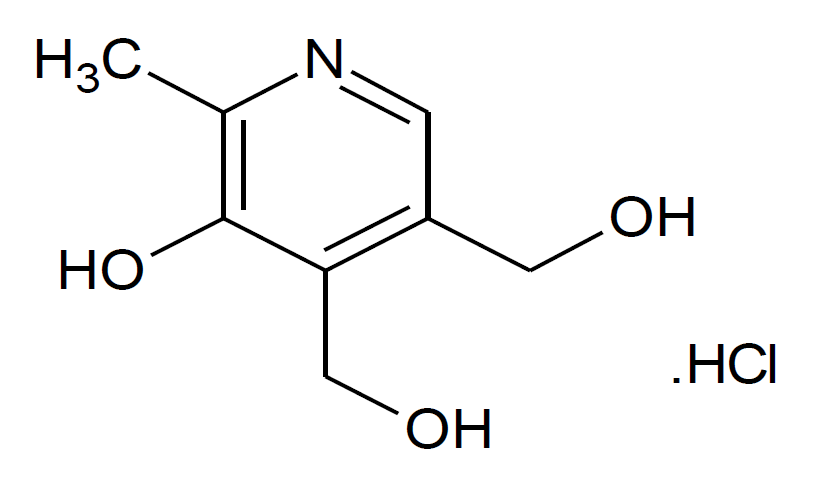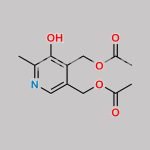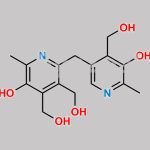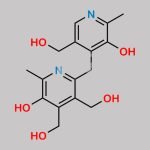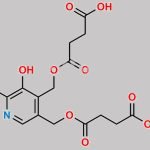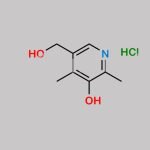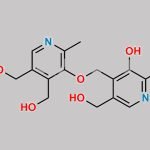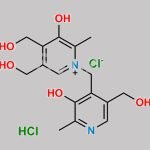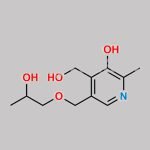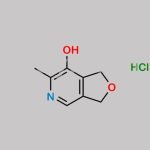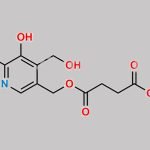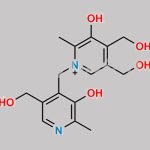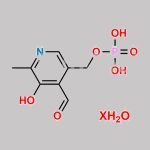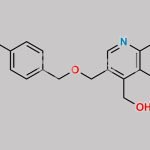| Synonyms | PYRIDOXINE HYDROCHLORIDE
58-56-0
Pyridoxol hydrochloride
Hexa-Betalin
Aderoxine
Alestrol
Bonasanit
Hexavibex
Hexermin
Hexobion
Pyridipca
Becilan
Beesix
Benadon
Pydox
Campoviton 6
Adermine hydrochloride
Hexabetalin
Aderoxin
Godabion
Paxadon
Pyridox
3,4-Pyridinedimethanol, 5-hydroxy-6-methyl-, hydrochloride
Aderomine hydrochloride
Hexabione hydrochloride
Pyridoxin hydrochloride
Hexa-Betalin (R)
Pyridoxinum hydrochloricum
Rodex (R)
4,5-Bis(hydroxymethyl)-2-methylpyridin-3-ol hydrochloride
Pyridoxol, hydrochloride
Pyridoxine monohydrochloride
VibeX
5-Hydroxy-6-methyl-3,4-pyridinedimethanol hydrochloride
Pyridoxine, hydrochloride
CCRIS 1903
Clorhidrato de piridoxina
HSDB 1212
2-Methyl-3-hydroxy-4,5-bis(hydroxymethyl)pyridine hydrochloride
EINECS 200-386-2
UNII-68Y4CF58BV
NSC 36225
NSC-36225
5-Hydroxy-6-methyl-3,4-pyridinedicarbinol hydrochloride
68Y4CF58BV
DTXSID1040792
CHEBI:30961
AI3-19016
5-Hydroxy-6-methyl-3,4-pyridinedimethanol, hydrochloride
3-Hydroxy-4,5-dihydroxymethyl-2-methylpyridine hydrochloride
DTXCID4010780
4,5-Bis(hydroxymethyl)-3-hydroxy-2-methylpyridine hydrochloride
Pyridoxine hydrochloride [USP:JAN]
TPN COMPONENT PYRIDOXINE HYDROCHLORIDE
BONJESTA COMPONENT PYRIDOXINE HYDROCHLORIDE
DICLEGIS COMPONENT PYRIDOXINE HYDROCHLORIDE
BENDECTIN COMPONENT PYRIDOXINE HYDROCHLORIDE
DICLECTIN COMPONENT PYRIDOXINE HYDROCHLORIDE
Pyridoxine hydrochloride (USP:JAN)
PYRIDOXINE HYDROCHLORIDE (MART.)
PYRIDOXINE HYDROCHLORIDE [MART.]
PYRIDOXINE HYDROCHLORIDE (USP-RS)
PYRIDOXINE HYDROCHLORIDE [USP-RS]
PYRIDOXINE HYDROCHLORIDE (EP IMPURITY)
PYRIDOXINE HYDROCHLORIDE [EP IMPURITY]
PYRIDOXINE HYDROCHLORIDE (EP MONOGRAPH)
PYRIDOXINE HYDROCHLORIDE (USP MONOGRAPH)
PYRIDOXINE HYDROCHLORIDE [EP MONOGRAPH]
PYRIDOXINE HYDROCHLORIDE [USP MONOGRAPH]
CitraNatalB-Calm
Rodex(R)
PYRIDOXINE HCI
B-6 Pyridoxine HCL
PYRIDOXINE HYDROCHLORIDE COMPONENT OF TPN
PYRIDOXINE HYDROCHLORIDE COMPONENT OF BENDECTIN
PYRIDOXINE HYDROCHLORIDE COMPONENT OF BONJESTA
4,5-Bis(hydroxymethyl)-2-methylpyridin-3-ol monohydrochloride
200-386-2
Pyridoxine HCl
Vitamin B6 hydrochloride
Pyridoxine chloride
Pyridoxinium chloride
Bendectin
PN HCl
Pyridoxine (hydrochloride)
MFCD00012807
3-Hydroxy-4,5-dimethylol-alpha-picoline hydrochloride
(5-hydroxy-6-methylpyridine-3,4-diyl)dimethanol hydrochloride
Adermin hydrochloride
8064-77-5
4,5-bis(hydroxymethyl)-2-methylpyridin-3-ol;hydrochloride
Pyridoxine hydrogen chloride
Spondylonal
Pyridoxin hydrochloride (Vitamin B6 hydrochloride)
Pyridoxol (hydrochloride);Vitamin B6 (hydrochloride)
4,5-bis(hydroxymethyl)-2-methyl-3-pyridinol hydrochloride
3,4-Pyridinedimethanol, 5-hydroxy-6-methyl-, hydrochloride (1:1)
Pyridoxinum hydrochloricum (Hungarian)
SMR000674613
Hexa-betalin (TN)
NSC36225
component of Alestrol
Tex Six T.R.
NCGC00164317-01
Vitamin B6-hydrochloride
Vitamin B6, hydrochloride
Pyridoxine hydrochloride [JAN]
Prestwick_925
Pyridoxini hydrochloridum
SCHEMBL42293
MLS001074329
MLS002153915
PYRIDOXINE HCL [VANDF]
Pyridoxine hydrochloride, 98%
3-Hydroxy-4,5-dimethylol-.alpha.-picoline hydrochloride
CHEMBL1200756
HY-N0682R
HMS1569N08
HY-N0682
PXB92112
Tox21_302476
PYRIDOXINE HYDROCHLORIDE [MI]
s3113
3-Hydroxy-4,5-Dimethylol-Alpha-Pic
Pyridoxine hydrochloride (JP17/USP)
PYRIDOXINE HYDROCHLORIDE [FCC]
AKOS015891679
Pyridoxine (hydrochloride) (Standard)
CCG-220623
CS-W020418
FP27320
PYRIDOXINE HYDROCHLORIDE [HSDB]
3, 5-hydroxy-6-methyl-, hydrochloride
PYRIDOXINE HYDROCHLORIDE [VANDF]
NCGC00180946-01
NCGC00256911-01
PYRIDOXINE HYDROCHLORIDE [WHO-DD]
PYRIDOXINE HYDROCHLORIDE [WHO-IP]
PYRIDOXINUM HYDROCHLORICUM [HPUS]
AC-12024
AS-11752
SY061587
WLN: T6NJ B1 CQ D1Q E1Q &GH
Pyridoxine hydrochloride, >=98% (HPLC)
DB-053225
Pyridoxine hydrochloride, p.a., 98-102%
NS00075617
P0561
PYRIDOXINE HYDROCHLORIDE [GREEN BOOK]
SW197042-3
PYRIDOXINE HYDROCHLORIDE [ORANGE BOOK]
D02179
H12039
EN300-7548938
PYRIDOXINI HYDROCHLORIDUM [WHO-IP LATIN]
VITAMIN B6 (AS PYRIDOXINE HYDROCHLORIDE)
Pyridoxine Hydrochloride (B6), analytical standard
Pyridoxine hydrochloride, plant cell culture tested
SR-05000001644-4
Q26841284
F0001-2400
Pyridoxine hydrochloride, SAJ special grade, >=98.0%
Pyridoxine hydrochloride, Vetec(TM) reagent grade, 98%
Pyridoxine hydrochloride, meets USP testing specifications
Pyridoxine Hydrochloride 1.0 mg/ml in Methanol (as free base)
3-Hydroxy-4,5-bis(hydroxymethyl)-2-methylpyridine hydrochloride
Pyridoxine hydrochloride, certified reference material, TraceCERT(R)
Pyridoxine hydrochloride, British Pharmacopoeia (BP) Reference Standard
Pyridoxine hydrochloride, European Pharmacopoeia (EP) Reference Standard
Pyridoxine hydrochloride, Pharmaceutical Secondary Standard; Certified Reference Material
Pyridoxine hydrochloride, United States Pharmacopeia (USP) Reference Standard
Vitamin B6 hydrochloride;2-Methyl-3-hydroxy-4,5-bis(hydroxymethyl)pyridine hydrochloride
Pyridoxine hydrochloride, BioReagent, suitable for cell culture, suitable for insect cell culture, suitable for plant cell culture |



